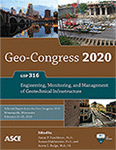Geo-Congress 2020
The Effects of Poor Design and Construction Workmanship on a Mechanically Stabilized Earth (MSE) Segmental Retaining Wall (SRW) in North Carolina
Publication: Geo-Congress 2020: Engineering, Monitoring, and Management of Geotechnical Infrastructure (GSP 316)
ABSTRACT
A two-tiered mechanically stabilized earth (MSE) segmental retaining wall (SRW) system with a maximum height of approximately 90 feet along its curving, concaved section was built at a new residential development near Asheville, North Carolina, in 2011. The two-tier section of the wall was approximately 400 feet in length where the upper wall was nested within the lower wall to account for a topographic depression and the site-specific grading. During the last layers of fill placement of the two-tier portion, substantial bulging, vertical deformations, and cracking along the face blocks of the wall were observed. As a result, the owner of the wall decided to demolish a significant portion of the upper wall. A detailed field investigation was performed, before and during the wall removal, to evaluate the as-built conditions of the MSE/SRW wall and to assess the potential factors that contributed to the observed movement and distress. The field investigation included detailed observations of various components of the wall: 1) backfill; 2) foundation; 3) geogrid reinforcement; 4) facing blocks; and 5) drainage system. This was done by means of 13 hand-dug test pits, 13 sand cone tests, and laboratory analyses of multiple bulk samples. The results of observations, testing, and analyses illustrate how standard design calculations for MSE/SRW walls do not incorporate the influence of some of these five components. In particular, concave sections of such walls as well as serviceability conditions are not very well accounted for by standard design practices. Finally, this paper provides insights into the design and construction practices that contributed to the observable deformations and distress in the wall, the importance of appropriate construction to appropriately match the design assumptions, and the relative effect of various site conditions on the performance of an MSE/SRW wall.
Get full access to this article
View all available purchase options and get full access to this chapter.
ACKNOWLEDGEMENTS
Exponent was retained on behalf of the geogrid manufacturer installed in this MSE/SRW wall. This analysis and testing were conducted on its behalf as part of Exponent’s investigation to evaluate the cause of the movements in the MSE/SRW wall. Exponent is grateful to the manufacturer for allowing us to use and analyze the data and report on these findings. The authors also wish to recognize the contribution of Dr. Macan Doroudian to the field work and draft of this paper.
REFERENCES
AASHTO (2012). “LRFD Bridge Design Specifications”.
ASTM (2012). “Standard Test Methods for Laboratory Compaction Characteristics of Soil Using Modified Effort (56,000 ft-lbf/ft3 (2,700 kN-m/m3)).” D1557, West Conshohocken, PA.
ASTM (2017). “Standard Specification for Dry-Cast Segmental Retaining Wall Units.” C1372, West Conshohocken, PA.
FHWA (2001). “Mechanical Stabilized Earth Walls and Reinforced Soil Slopes Design & Construction Guidelines”, Publication No. FHWA-NHI-00-043.
Haddad, D, Shafabakhsh, G (2008). “Failure of Segmental Retaining Walls Due to the Insufficiency of Backfill Permeability”, Geosynthetics in Civil and Environmental Engineering, pp 852-856.
Look, BG, (2016). “Different Conclusions for a Retaining Wall Failure with Saturated vs. Unsaturated Soil Mechanics”, Geotechnical and Structural Engineering Congress 2016.
NCMA (2016). “Segmental Retaining Walls Best Practices Guide for the Specification, Design, Construction, and Inspection of SRW Systems”.
Roy, D, Singh, R, (2008). “Mechanically Stabilized Earth Wall Failure at Two Soft and Sensitive Soil Sites”, Journal of Performance of Constructed Facilities, 22: 6, Dec.
Yoo, C, Jung, HY, (2006). “Case History of Geosynthetic Reinforced Segmental Retaining Wall Failure”, Journal of Geotechnical and Geoenvironmental Engineering, 132: 12, Dec.
Information & Authors
Information
Published In
Geo-Congress 2020: Engineering, Monitoring, and Management of Geotechnical Infrastructure (GSP 316)
Pages: 530 - 542
Editors: James P. Hambleton, Ph.D., Northwestern University, Roman Makhnenko, Ph.D., University of Illinois at Urbana-Champaign, and Aaron S. Budge, Ph.D., Minnesota State University, Mankato
ISBN (Online): 978-0-7844-8279-7
Copyright
© 2020 American Society of Civil Engineers.
History
Published online: Feb 21, 2020
ASCE Technical Topics:
- Construction engineering
- Construction industry
- Construction management
- Construction sites
- Continuum mechanics
- Deformation (mechanics)
- Engineering fundamentals
- Engineering mechanics
- Field tests
- Geotechnical engineering
- Geotechnical investigation
- Penetration tests
- Residential construction
- Retaining structures
- Solid mechanics
- Structural engineering
- Structural mechanics
- Structural members
- Structural systems
- Tests (by type)
- Walls
Authors
Metrics & Citations
Metrics
Citations
Download citation
If you have the appropriate software installed, you can download article citation data to the citation manager of your choice. Simply select your manager software from the list below and click Download.
